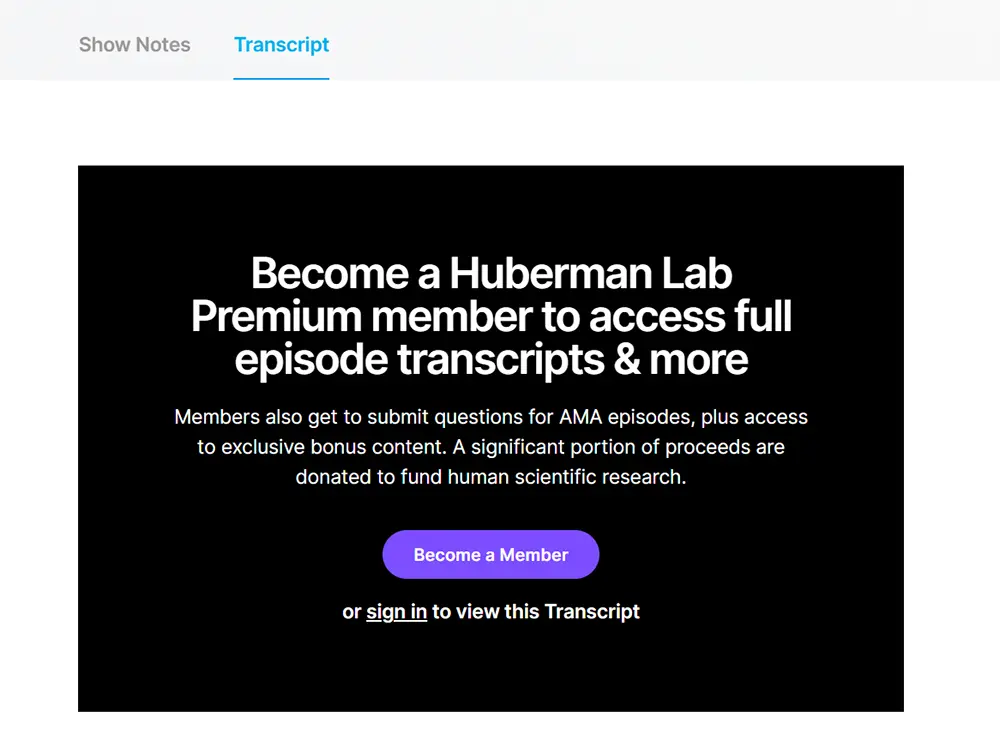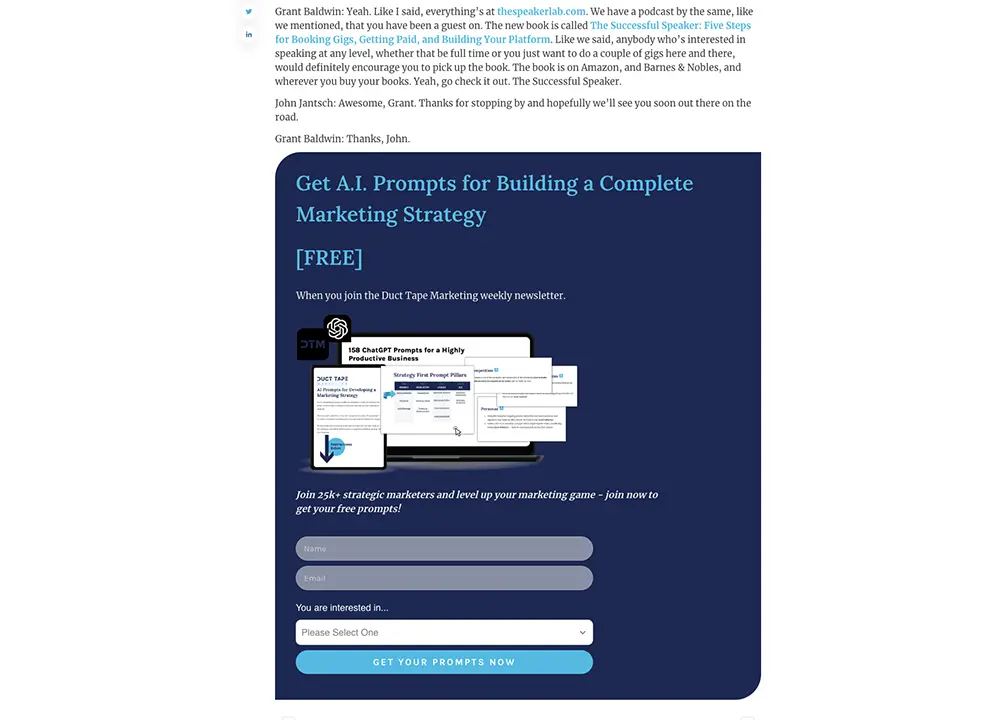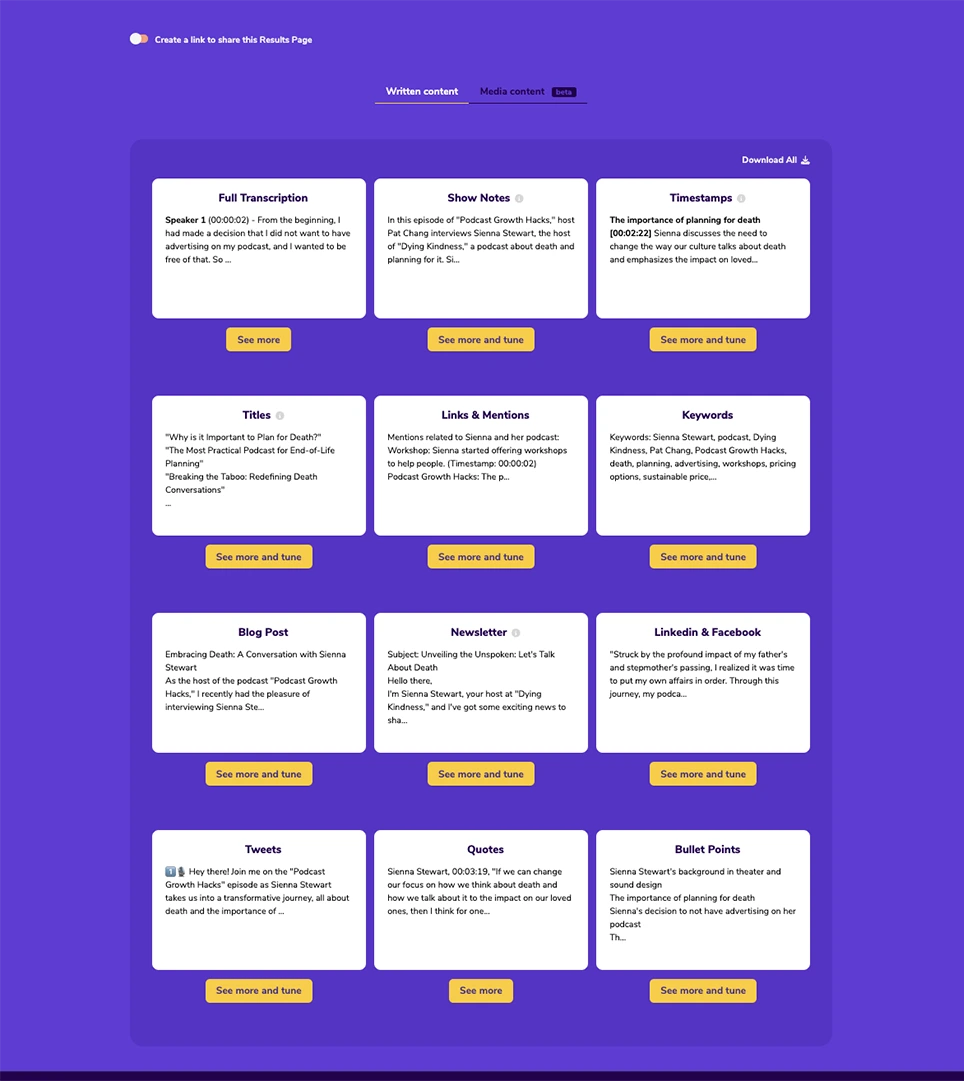BLOG ARTICLE
Everything you need to know about podcast transcription
Last updated: 12/22/2025
Last updated: 12/22/2025
Podcast transcription is a powerful but often overlooked way to make your podcast more accessible, engaging and profitable. In this article, you will learn everything you need to know about it, including:
- What are podcast transcripts and why they matter
- Effective techniques to make your transcripts more engaging, with real life examples
- How to use transcripts to boost your podcast’s growth and revenue
- How to outsource your podcast transcription to save time and streamline your worflow
Let’s dive in, shall we 👇

What are podcast transcripts
A Podcast transcript is the text-based version of a podcast that includes every word that was discussed in a podcast episode.
A transcript makes your podcast accessible and more readable. Whether the listener got distracted, couldn't catch what you said, or simply didn’t have the time to listen to your entire podcast, having a transcript ensures that they can always go back and catch up on what they missed.
You can either choose to write a podcast transcript manually by typing out your podcast word-for-word or use an AI transcription tool to write the transcript for you.
Podcast transcripts are usually included directly on the podcast’s website or made accessible through download links. You can create a downloadable version of your transcript in PDF or Google Docs and share the link within your show notes. This is especially beneficial when publishing transcripts on podcasting directories, as their episode description sections often have character limits that may not accommodate a full transcript.

Podcasters often underestimate the value of transcripts, viewing them as dull text-heavy content that doesn't receive the same attention as show notes and episode descriptions. However, the reality is that transcripts can bring numerous benefits to your podcast.
Benefits of Podcast Transcripts
1) Search Engine Optimization
Search engines, such as Google, face challenges when it comes to indexing and ranking podcasts. This is because their algorithms are primarily designed for text-based content, making it difficult for them to comprehend audio. As a result, podcasts may experience limited reach and visibility in search results.
This is where having a podcast transcript can help.
Podcast transcripts provide a detailed, word-for-word textual representation of your podcast episode, encompassing all the essential keywords related to the topic. This not only enables Google to easily comprehend the content but also enhances visibility when users search for topics associated with your episode.
Transcripts play a crucial role in elevating two essential factors in search engine ranking: keyword density and keyword variability.
Keyword density refers to how frequently a particular keyword or phrase appears in your content. Maintaining a reasonable keyword density is vital for search engines to understand the relevance of your content.
When you record a podcast, the natural flow of conversation often leads to the organic repetition of keywords. A podcast transcript captures this, contributing to achieving a favorable keyword density.
Keyword variability involves using synonyms, related terms, and variations of the main topic in your content to broaden the spectrum of keywords your content ranks for on Google.
For example, during a podcast on mountain trekking, you might naturally incorporate synonyms like "top hiking paths" or "backcountry trails." This intentional variation adds depth to the keywords, making your content align with a diverse range of search queries when the transcript is published.
2) Monetization Opportunities
Transcripts offer several opportunities for generating revenue out of your podcast and maximizing the value from it.
These include:
Selling transcripts: You can convert your podcast episode’s transcript into a PDF file & sell it as a product on your website that listeners can buy if they want a readable version of your episode. Some listeners may be interested in gaining access to your episode transcripts as they serve as a valuable tool for research and note-taking, allowing them to easily find specific information or quotes from the episode without having to replay the entire audio. You can also bundle together the transcripts of a series of 10-15 episodes around a particular topic, and put them together into an ebook which you can sell on Gumroad Or Amazon.

Offer Subscriptions: Implement a subscription through a platform like Patreon or Buy Me A Coffee, where subscribers gain access to all your transcripts along with exclusive content and other perks for joining your membership. This can create a recurring revenue stream and encourage loyalty among your audience.


Affiliate Marketing: Add affiliate links to products and resources that are mentioned or recommended by you throughout the episode within your transcripts. So whenever the reader purchases from your link, you make a commission.
You can join the Amazon affiliate program, to add an affiliate link to products (Ex: books, electronics,etc) that are mentioned in your episode.
For example: If you run a fitness podcast and you recommend a particular fitness band in your episode, You can add an affiliate link to purchase it on Amazon.
Boost Engagement
Transcripts don't need to be long and tedious blocks of text. In fact, you can customize the format of your transcripts and website transcript pages, enhancing your audience's listening experience and engagement with your content. Here are some examples:

The Good Morning Podcasters show integrates their transcripts into the show notes pages, featuring clickable timestamps. This enables listeners to effortlessly navigate to specific parts of an episode they find interesting while reading the transcript.

The Borrowed Podcast includes a neatly formatted transcript on its episode page:
- The content is broken down into single lines or short paragraphs
- Quote blocks are used to highlight segments where interviewees are speaking
- Images are added to the transcript to make the podcast more human
All these factors make the transcript more engaging and readable for the listeners.

The Duct Tape Marketing podcast takes a different approach by publishing transcripts on a separate page on their website, allowing direct linking from podcast directories where lengthy transcripts can't be posted.
Their transcripts make it easier for listeners to engage with the content by sharing the links to all the resources that were mentioned on the podcast episode. Additionally, a call-to-action is included at the bottom of the page, urging readers to join the newsletter if they are interested in learning more.

4) Repurposing Your Content
A podcast transcription is a powerful way to expand the lifespan of your content, increasing engagement, and reaching a broader audience by facilitating repurposing into multiple content formats across various platforms.
Transcripts act as a foundational script, providing a convenient starting point for creating diverse content pieces such as:
- Blog posts and articles to boost your SEO
- Social media posts to grow your social media presence
- Email newsletters that help you grow your subscribers and engage with your audience
Furthermore, the transcript streamlines the process of identifying compelling quotes and segments, to create quote images and clips for social media sharing.
5) Improve Accessibility
Over 37.5 million Americans have trouble hearing, according to the NIDCD report. And this number gets much bigger, when you consider people from around the world.
Transcripts bridge this accessibility gap, ensuring that everyone, regardless of their hearing abilities, can access and enjoy your content.
Transcripts also make it easier to consume your podcast for audiences who are:
Non-Native speakers: For non-native speakers, picking up Accents, dialects, and the pace of language can be difficult while listening to a podcast. They hugely benefit from transcripts which lets them follow your podcast at their own pace without any trouble.
Convenience for busy subscribers: Not everyone has the time to sit down and listen to a lengthy podcast. Transcripts offer a time-saving solution for individuals with busy schedules. It allows them to quickly scan the written transcripts to find specific information or engage with the podcast's insights during short breaks, commutes, or other spare moments.
How to Streamline Writing Podcast Transcripts
As mentioned in the beginning of this article, there are 2 ways to write your podcast transcript.
- Manual Transcriptions
- And AI Transcriptions
Manual podcast transcription is when a human transcriber listens to the podcast and types out the words that are spoken. This method can produce high-quality transcripts that are accurate and capture the nuances of the speech. However, manual podcast transcription can also be time-consuming, labor-intensive, and costly.
AI podcast transcription is when a software tool or a website uses artificial intelligence to convert audio into text. This method can produce fast and cheap transcripts that are convenient and easy to use. However, AI podcast transcription might face challenges with low-quality audio and strong accents.
The cost of outsourcing podcast transcripts can vary depending on the method and the service provider. There are three main methods of outsourcing podcast transcripts:
Hiring a podcasting agency: Agencies offer professional service that can handle all aspects of podcast production, including transcription. They usually offer high-quality transcripts with fast turnaround times and customized features. However, they can also be the most expensive option, with rates ranging from $1.50 to $3.00 or more per audio minute.

Hiring a freelancer: This is a more flexible and affordable option, as you can choose from a variety of freelancers who offer transcription services on platforms like Fiverr. You can compare prices, reviews, and samples of their work, and negotiate the terms and deadlines. The quality and speed of the transcripts may vary depending on the freelancer, but the average rate is around $1.00 per audio minute.
Using an AI service: This is the most affordable and fastest option, as you can use a software tool or a website that uses artificial intelligence to convert audio into text. AI services charge as low as $0.10 per audio minute, however, the accuracy of the transcripts may not be as good as human transcription for complex or accented speech and low quality audio.
Using AI to transcribe your podcast
In contrast to hiring an agency or freelancer and spending hours and even days waiting for deliverables, Podsqueeze allows you to generate transcriptions for your episodes within minutes with just a simple click. Utilizing industry-leading transcription technology, Podsqueeze ensures accuracy that rivals manual transcription but at a significantly lower cost.
Moreover, with an AI transcription tool like Podsqueeze, you gain the added benefit of automatically repurposing your transcript into blog posts, newsletters, and social media posts. This feature enhances your content's reach across various platforms, eliminating the need for additional promotional efforts for your podcast.
Once you have finished recording your podcast, getting started with AI transcriptions is easy.
Just follow these simple steps to automatically generate transcripts for your podcast through AI transcription.
- Sign up for a free Podsqueeze account
- Click on the “Generate content” button in your Dashboard
- Select your podcast name using the search bar or upload your podcast’s audio/video file from your computer

- Pick the episode you wish to transcribe.

- Finally click the ”Generate Content” button and sit back

In just a few minutes, Podsqueeze will automatically generate a word-for-word transcript of your podcast. You can either directly copy the transcript to use on your website or choose to download it as an SRT file, a standard file format for video captions and subtitles.

But that’s not all. Podsqueeze also repurposes your transcript into multiple content pieces to help you promote your podcast on all platforms without any extra effort from your end.

Here is the list of content you get when you transcribe your podcast with Podsqueeze:
- The complete written transcript and SRT file for subtitles
- Podcast description
- Chapters with timestamps
- Title suggestions for your podcast episode
- Blog posts with title and subtitles
- Newsletter content to share by email with your subscribers
- LinkedIn posts, facebook posts & tweets to promote on on social media
- Quotes mentioned on your podcast by you and your guests to use on instagram/pinterest
- Bullet points of key takeaways from the podcast
- Clips with engaging segments from your podcast to share on social media
Podsqueeze offers a free tier with upto 50 minutes of podcast time per month, allowing you to test it out with your podcast before deciding to subscribe.
Repurpose your podcast content with AI